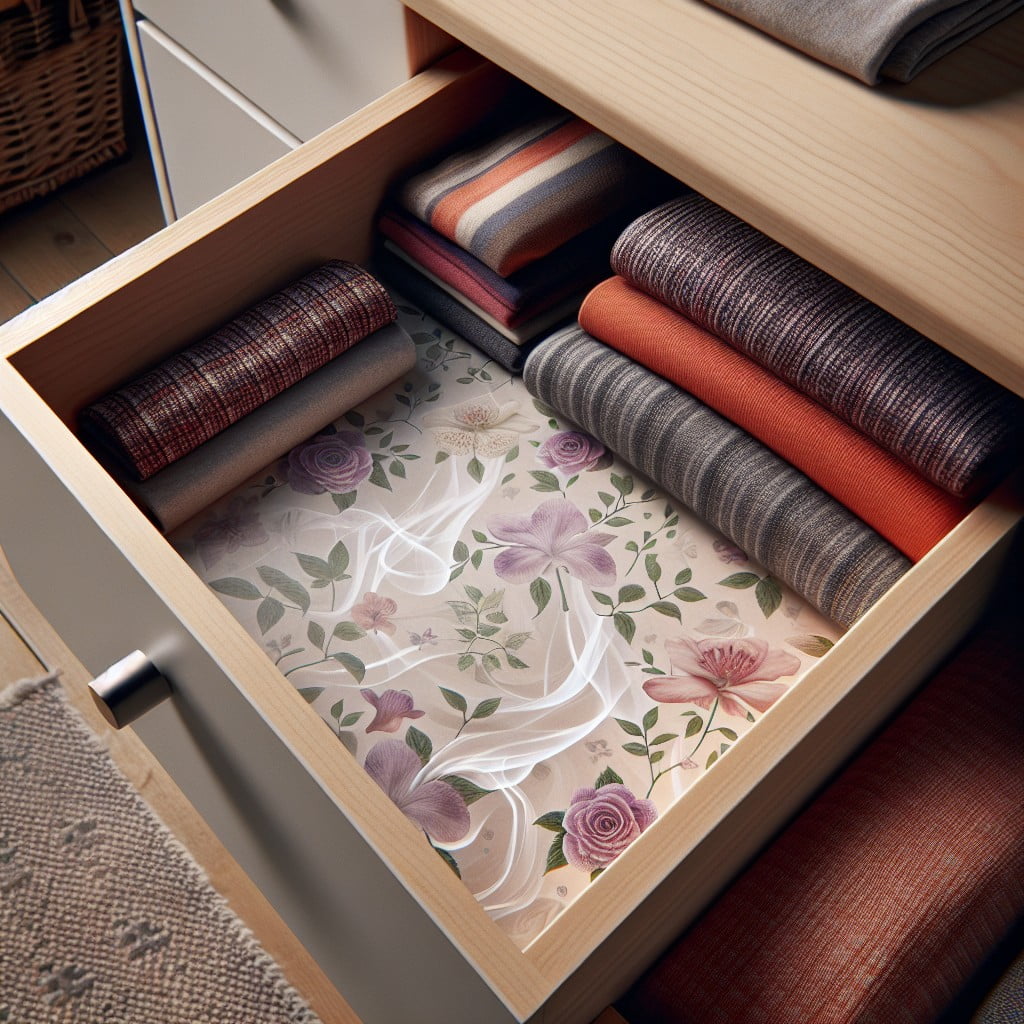Last updated on
Dipping into an assortment of drawers, you’ll unveil a sea of freshness with every fabric swatch because this article offers indispensable tips on how to keep your clothes smelling clean and fresh in drawers.
Key takeaways:
- Ensure clothes are thoroughly clean before storage
- Use airtight containers for storing clothes
- Line drawers with scented drawer liners
- Utilize sachets filled with dried herbs or potpourri
- Incorporate dryer sheets between layers of clothing
Ensure Clothes Are Thoroughly Clean Before Storage

Storing clothes without ensuring they’re completely clean can lead to musty odors and even attract pests. Residual oils, sweat, and dirt could cause fabrics to develop a stale smell over time.
Follow these points to guarantee freshness:
- Wash or dry-clean garments according to the care label instructions before storing them, as invisible stains can oxidize and become visible over time.
- Ensure clothes are bone-dry to prevent mold and mildew growth; even a slight dampness can cause problems.
- For items that can’t be washed, such as delicate silks or wools, consider airing them out for a day in a space with good air circulation before placing them in the drawer.
- Attack stubborn odors by adding a half cup of baking soda to the wash cycle, which can neutralize smells without harming fabrics.
By starting with clean, dry clothing, you set the stage for maintaining a fresh and pleasant drawer environment.
Use Airtight Containers for Storing Clothes

Storing clothes in airtight containers is an effective method to keep them smelling fresh. These containers prevent the ingress of moisture, dust, and pests, all of which can lead to musty odors.
When choosing an airtight container, opt for clear, plastic bins that allow you to see the contents without opening them. This not only preserves the freshness but also makes it easy to find your clothes.
Remember to confirm the clothing is completely dry before sealing it inside to avoid mold and mildew growth. If you’re storing for an extended period, throw in a silica gel packet to absorb any residual moisture.
Seal the container tight and stack it neatly in your drawer or closet, ensuring your garments remain in pristine condition until the next wear.
Line Drawers With Scented Drawer Liners

Drawer liners infused with pleasant aromas offer a dual benefit: they protect your garments from rough wood or other materials that might snag fabrics, and they gently infuse clothes with a fresh scent.
Choose from a variety of scents – from lavender to ocean breeze – to suit your personal preference.
Simply cut the liners to size and place them at the bottom of your drawers.
For a longer-lasting effect, opt for liners that can be spritzed with a compatible scent to refresh the fragrance periodically.
In addition to their olfactory advantages, these liners often come in charming patterns that add a touch of visual appeal to your drawers when you open them.
Utilize Sachets Filled With Dried Herbs or Potpourri

Sachets filled with natural scents offer an easy and effective way to maintain a pleasant aroma in your clothes drawers. To maximize their benefits:
1. Choose your favorite dried herbs, such as lavender or rosemary, which not only smell great but also have natural moth-repellent properties.
2. When using potpourri, select blends with essential oils to ensure a longer-lasting fragrance.
3. Encase the herbs or potpourri in breathable fabric like cotton or muslin to allow the scent to diffuse.
4. Replace sachets every few months, or refresh them with a few drops of essential oils to maintain their efficacy.
5. Experiment with different scents in separate drawers to create a customized scent profile for your garments.
Incorporate Dryer Sheets Between Layers of Clothing
Dryer sheets can double as an effective means to keep your garments pleasantly scented while tucked away in drawers. These sheets, typically used during the drying process to soften fabrics and reduce static, contain a specific fragrance that can impart a fresh smell onto clothes.
Here’s how to use them effectively:
- Place a dryer sheet between folded clothes to subtly infuse the scent throughout the stack.
- Replace the dryer sheets periodically, as their scent fades over time, to ensure a continuous fresh aroma.
- Opt for dryer sheets with natural scents or those labeled as hypoallergenic if you have sensitive skin or prefer less intense fragrances.
- To prevent potential oil stains, make sure the sheet doesn’t directly touch delicate fabrics. You might wrap it in a thin cloth or place it on top of a tissue paper before laying it between clothes.
By interleaving dryer sheets, you can maintain a closet that not only looks organized but also smells clean and fresh every time you open the drawer.
Store a Small Pouch of Activated Charcoal in Drawers
Activated charcoal is a powerful odor neutralizer, thanks to its porous nature that absorbs moisture and pollutants from the air. For effective use in your drawers:
- Choose small pouches or sachets specifically designed for air purification.
- Place one pouch in each drawer, ideally in the corner, to optimize space.
- Replace the charcoal every two to three months or as needed, depending on the level of odors.
- If the charcoal sachets come with hooks or strings, consider hanging them to maximize air contact.
- Before use, ensure the charcoal is free from dust or debris to avoid soiling clothes.
By tackling odors at a molecular level, the charcoal keeps garments smelling fresh without adding any scent.
Place Cedar Blocks or Cedar Sachets in Drawers
Cedar is renowned for its natural ability to repel moths and other insects while imparting a fresh, woodsy scent. To leverage cedar’s benefits:
1. Opt for untreated cedar blocks or balls, which can be placed in corners or along drawer edges.
2. Refresh the potency of cedar items by lightly sanding the surface every few months, which releases fresh oils and enhances the fragrance.
3. Replace cedar sachets annually as their scent diminishes over time; these sachets are convenient for tucking into folded garments.
4. If concerned about cedar oil staining, place blocks atop a small piece of fabric to protect clothing.
By incorporating cedar into your drawer storage strategy, clothes not only remain fresh but are also protected from unwanted pests.
Use Essential Oils On Cotton Balls As a Natural Fragrance Enhancer
Select your favorite essential oil—lavender for a soothing aroma or lemon for a crisp, clean scent.
Place a few drops onto a cotton ball and tuck it into corners or between stacks of clothing. The oil will gradually diffuse, giving your garments a pleasant smell.
Refresh the cotton balls every few weeks to maintain the fresh scent. For a lighter fragrance, seal the scented cotton balls in a small, breathable fabric bag before placing them in the drawer.
This method not only keeps clothes smelling fresh but also capitalizes on the potential benefits of aromatherapy.
Employ Baking Soda to Absorb Odors
Baking soda, a common household staple, is a natural odor absorber. Its ability to neutralize acidic and basic odors makes it an excellent choice for maintaining freshness in your drawers.
To use, sprinkle a thin layer of baking soda across the bottom of the drawer before placing clothes inside. Alternatively, pour some into a small, breathable fabric bag or an old sock tied at the end and tuck it into a corner.
This method is not only effective but also economical. Remember to replace the baking soda every few months, or when you notice the scent returning, to ensure continued freshness.
Maintain a Moisture-free Environment By Using Silica Gel Packets
Silica gel packets are a secret weapon against dampness in your drawers. These small sachets absorb excess moisture that can lead to musty odors.
Tuck them into the corners of your drawers or amid folded clothes to prevent a stale scent from developing. They work by trapping moisture from the air, creating a dry environment that helps keep clothes smelling fresh for longer.
Remember to replace silica gel packets periodically since their effectiveness decreases as they absorb maximum moisture. Also, if you have children or pets, make sure to place these packets out of their reach as they are not safe to ingest.
Implement Proper Folding Techniques to Allow Air Circulation
Maximizing the flow of air around your garments can significantly contribute to keeping them fresh. Here are some tips to achieve this:
- Avoid overpacking: Give your clothes some room to breathe by not stuffing drawers too full.
- Fold neatly: A tidy, uniform fold allows for small gaps between items, facilitating better airflow.
- Stack smartly: Place heavier items at the bottom and lighter, more delicate pieces on top to prevent compression and allow air to move freely.
- Keep it uncluttered: Regularly reorganize and declutter to maintain optimal spacing, which also makes it easier to find what you’re looking for.
- Refresh folding patterns: Change how you fold your clothes periodically to alter the points of pressure and airing, helping to distribute freshness evenly.
Consider Using Garment Bags for Delicate or Seldom-used Items
Delicate fabrics like silk, wool, or lace benefit greatly from the extra protection garment bags provide. By sheathing these items individually, you shield them from the potential rough-and-tumble of a crowded drawer, preserving their condition and scent.
For items that only make an appearance on special occasions, garment bags prevent the transfer of odors from more frequently worn clothes. Moreover, these bags can also serve as a barrier against pests, ensuring that an unwelcome moth doesn’t make a meal of your cherished garments.
For an additional freshness boost, consider slipping a sachet filled with lavender or your preferred dried herbs into the bag. This not only keeps your clothes smelling pleasant but also promotes a subtle, long-lasting fragrance without the need for chemical fresheners.
Remember to choose breathable garment bags for natural fibers to avoid trapping any moisture, which can lead to mildew growth and unpleasant odors.
Regularly Clean and Vacuum the Insides of Drawers to Remove Dust and Potential Odor Sources
Keeping drawers immaculate is essential for maintaining fresh-smelling clothing. Over time, dust and small particles accumulate, carrying odors that can transfer to your garments. To deter these unwanted smells, regularly empty your drawers and use a vacuum with an upholstery attachment to remove dirt from corners and crevices.
This not only prevents the buildup of musty scents but also guards against allergens that might linger in your storage space. Moreover, wiping down the interior with a damp cloth can pick up any remaining dust and helps to tackle potential stains before they become a problem.
Doing this cleaning routine every few months ensures that the environment your clothes rest in remains as clean and fresh as the day you laundered them.
How to Get Stale Smell Out of Clothes
To revive clothes that have developed a stale odor, start by airing them out. Hang them outside on a breezy day, away from direct sunlight to prevent fading. If outdoor space isn’t available, a well-ventilated room can serve as an alternative.
For persistent smells, mix a solution of equal parts water and white vinegar, soak the garments for an hour, then wash as normal. The vinegar’s acetic acid neutralizes odor-causing bacteria without leaving behind its own scent post-washing.
For delicate fabrics, consider using a spray bottle to lightly mist the clothing with a diluted vodka solution, another effective odor-neutralizer. Allow the garments to dry completely before returning them to your drawers.
Sometimes, simply washing the clothes with a cup of baking soda added to the laundry cycle can eliminate odors. Baking soda, a natural deodorizer, works wonders in breaking down scent molecules.
Lastly, if the clothing isn’t dirty but just needs refreshing, using a fabric steamer can help. The steam not only removes wrinkles but also kills most bacteria and mites, which can be responsible for the unpleasant smells.
Why Do Clothes Smell After Being Stored?
Clothing stored for extended periods can develop an off-putting odor due to several factors. Lack of air circulation in a packed drawer traps moisture, creating a breeding ground for mildew and mold. Fibers naturally absorb smells from their surroundings, thus, if stored in an area with a strong scent, your clothes will likely take on those odors.
Moreover, any residual body oils or stains that are not thoroughly cleaned prior to storage can decompose over time, releasing unpleasant smells. Furthermore, the very material of your clothing can attract moisture, bacteria, and insects, all of which contribute to unwanted scents.
To keep your wardrobe fresh, it’s crucial to address these underlying issues.
FAQ
Why do my clothes smell after sitting in my drawer?
Your clothes may emit an unpleasant smell after sitting in your drawer due to the growth of mildew, a type of fungus that thrives in stagnant, damp, and dark environments such as closed spaces.
How do I stop my drawers from smelling my clothes?
To stop your drawers from smelling your clothes, consider utilizing natural deodorizers such as baking soda, or placing cedar blocks, chips, or balls infused with a few drops of essential oils to both add a pleasant aroma and deter insects.
What can I put in my drawers to stop the musty smell?
To eliminate a musty smell from your drawers, place a bowl of baking soda inside each one, close them and leave it for a week.
What are some eco-friendly practices to keep drawers odor-free?
Some eco-friendly practices to keep drawers odor-free include using natural odor-absorbers like baking soda, activated charcoal, or dried herbs/flowers, encouraging proper ventilation, and regular cleaning with vinegar or lemon juice.
How often should I clean out and air my clothes drawers to prevent build-up of bad odors?
Clothes drawers should be cleaned out and aired approximately once every 3-6 months to prevent the build-up of unpleasant odors.
Can certain types of drawer materials contribute to bad smells in clothes, and what should I choose instead?
Yes, some drawer materials such as particle board or laminate can have a chemical smell that may impregnate clothes, but choosing materials like solid wood or metal can reduce the risk of bad smells.
Recap:





